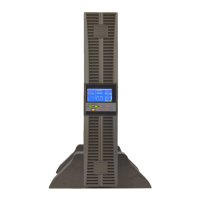
Do you have a question about the INVT HT1101S and is the answer not in the manual?
Adhere to all warnings, maximum load limits, and operating instructions for safe UPS use.
Follow specific precautions when handling batteries due to electrical shock and short circuit risks.
Details safety compliance and electromagnetic interference/sensitivity standards for the UPS.
Specifies operating conditions, prohibited actions, and cleaning instructions for safe UPS operation.
Introduces the 1-3kVA UPS, its purpose, and features like LCD display and function buttons.
Explains surge protection and filtering of electromagnetic and radio frequency interference.
Describes how the PFC circuit converts AC to DC and improves input current waveform.
Explains the inverter's role in converting DC to AC for clean, regulated output power.
Details the battery charger's function and the DC-to-DC converter's role in voltage regulation.
Covers battery types, operating temperature, and the automatic transfer to bypass during UPS malfunction.
Identifies applicable models, distinguishing between standard and long backup time variants.
Lists power rating, frequency, input/output voltage, battery numbers, dimensions, and weight for 1K, 2K, 3K models.
Details input electrical characteristics like voltage, frequency, and power factor.
Outlines output voltage regulation, power factor, frequency tolerance, distortion, and overload capacity.
Defines temperature, humidity, altitude limits, and storage temperature for optimal UPS operation.
Instructions for unpacking the UPS, checking contents, and inspecting for transport damage.
Covers installation modes, notes, and procedures for tower installation.
Procedure for connecting external battery packs for long backup time models, including voltage and current considerations.
Identifies and explains the functions of the ON/OFF and FUNC buttons on the display panel.
Explains the meaning of REC, INV, BYP, and BAT indicator lights based on their color and status.
Details the information displayed on the LCD screen, including input, warn, battery, load, and output status.
Lists conditions like battery discharge, low battery, and overload that trigger audible alarms.
Provides step-by-step instructions for turning the UPS on in normal mode or from battery, and turning it off.
Guidelines for charging, lifespan, and replacement of UPS batteries, emphasizing qualified personnel.
Detailed steps for safely removing and replacing the internal battery pack of the UPS.
Safety guidelines for disposing of batteries, including personal protection and avoiding fire hazards.
Procedure for replacing batteries, including disconnecting wires, removing fasteners, and reconnecting.
Recommendations for checking UPS status and identifying fault/warn codes.
Lists common fault/warn codes, their possible causes, and solutions for troubleshooting UPS issues.
Details specific fault and warning conditions like inverter fault, over-temperature, and fan failure with contact information.
Information required when reporting a UPS fault, including model, serial number, and fault codes.
Details the pin functions and wiring diagrams for DB9 and Phoenix terminator intelligent slots.
Explains the optional EPO function for complete UPS shutdown in emergencies via remote contact.
Procedure to enter setting mode and set UPS voltage and frequency using panel buttons.
Instructions for configuring operating mode (normal/ECO) and communication protocol (Modbus/SNT).
Process for saving the current settings or exiting the setting mode without saving.
Step-by-step instructions for assembling the 1k battery kit, including tape removal and connection.
Instructions for assembling the 2k battery kit, covering tape removal, terminal connection, and shell assembly.
Guide for assembling the 3k battery kit, detailing tape removal, battery connection, and final assembly.